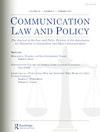Dworkin, Ronald. Hard Cases, 88 Harv. L. Rev. 1057 (1975)
IF 0.2
Q4 LAW
引用次数: 2
Abstract
When considering cases involving the First Amendment, the Communications Commission Acts of 1934 or 1996, and Federal Communications Commission orders, one should begin by considering three overarching related questions: When interpreting cases, what do judges do, and what should they do?With respect to the First Amendment, how do or should judges determine the meaning of “speech,” “press,” “assemble,” or petition “for a redress of grievances”? What makes something a “law,” andwhenwould this something “abridge” these “freedoms”? To perhaps oversimplify, the philosophy of law has offered two main approaches to answering these questions. One, legal positivism, is that the law is a collection of factual statements about legality, much as chemistry is a collection of factual statements about atomic interactions. This includes identification of a process by which judges (and the public) recognize which statements about conduct are laws. One prominent such process is positive originalism — the import of “positive” to be explained — in which instructions about the content of the law can be found in what those who enacted the law believed to be what it specifically delineated. The other answer, at the extreme opposite, is legal realism. In this view, the law is what judges say it is. To invoke a familiar metaphor from baseball, legal positivism is the umpire saying, “I call ‘em as they is,” and legal realism is “I call ‘em as I see ‘em.” A modern variant on legal realism is critical legal studies, which places courts as part of the overarching set of power relations in society or, as the baseball metaphor concludes, with the umpire saying, “They ain’t nothin’ ‘til I call ‘em.” Volumes have been written on these two philosophies. Legal positivism strips law of its normative force, that breaking the law is not just imprudent but wrong. Using dated applications to delineate the law seems inadequate as societies become more complex. Legal realism德沃金,罗纳德。硬壳,88 Harv。L.修订版1057(1975)
在审议涉及第一修正案、1934年或1996年《通信委员会法案》和联邦通信委员会命令的案件时,应首先考虑三个相关的首要问题:在解释案件时,法官该做什么,他们应该做什么?关于第一修正案,法官如何或应该如何确定“言论”、“新闻”、“集会”或“申诉冤屈”的含义?是什么使一件事成为“法律”?这件事什么时候会“剥夺”这些“自由”?也许过于简单地说,法哲学提供了两种主要的方法来回答这些问题。一种是法律实证主义,即法律是关于合法性的事实陈述的集合,就像化学是关于原子相互作用的事实陈述集合一样。这包括确定法官(和公众)承认哪些关于行为的声明是法律的程序。其中一个突出的过程是积极原创主义——需要解释的“积极”的含义——在这种过程中,关于法律内容的指示可以在制定法律的人认为是法律具体描述的内容中找到。另一个答案恰恰相反,是法律现实主义。在这种观点中,法律就是法官所说的。借用棒球中一个熟悉的比喻,法律实证主义是裁判说,“我按原样称呼他们”,而法律现实主义是“我按我所见称呼他们”。法律现实主义的现代变体是批判性法律研究,它将法院视为社会权力关系的一部分,裁判说:“除非我叫他们,否则他们什么都不是。”关于这两种哲学已经写了很多卷了。法律实证主义剥夺了法律的规范性力量,认为违法不仅是轻率的,而且是错误的。随着社会变得越来越复杂,使用过时的申请来描述法律似乎是不够的。法律现实主义
本文章由计算机程序翻译,如有差异,请以英文原文为准。
求助全文
约1分钟内获得全文
求助全文
来源期刊
CiteScore
0.60
自引率
33.30%
发文量
7
期刊介绍:
The societal, cultural, economic and political dimensions of communication, including the freedoms of speech and press, are undergoing dramatic global changes. The convergence of the mass media, telecommunications, and computers has raised important questions reflected in analyses of modern communication law, policy, and regulation. Serving as a forum for discussions of these continuing and emerging questions, Communication Law and Policy considers traditional and contemporary problems of freedom of expression and dissemination, including theoretical, conceptual and methodological issues inherent in the special conditions presented by new media and information technologies.

 求助内容:
求助内容: 应助结果提醒方式:
应助结果提醒方式:


